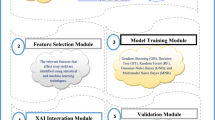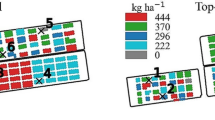Abstract
A hybrid soft decision model has been developed in this paper to take decision on agriculture crop that can be cultivated in a given experimental land by integrating few soft computing techniques. The proposed model comprises of three parts, namely weight calculation, classification and prediction. Twenty-seven input criteria were categorized into seven broad criteria, namely soil (11 sub-criteria), water (2 sub-criteria), season (no sub-criterion), input (6 sub-criteria), support (2 sub-criteria), facilities (3 sub-criteria) and risk (2 sub-criteria). In the proposed model, relative weights of main criteria were calculated using Shannon’s Entropy method and relative weights of sub-criteria in each main criterion were calculated using rough set approach. As VIKOR method is effective in sorting the alternatives, it is used to determine the ranking index of main criteria in this study. A soft decision system was constructed from the results of rough set method, VIKOR method and Shannon’s Entropy method. Classification rules were generated for five agriculture crops, namely paddy, groundnut, sugarcane, cumbu and ragi based on the soft decision system using bijective soft set approach. The developed model predicts each site in the validation dataset into one of the five crops. The performance of the proposed model has been sanity checked by agriculture experts.



Similar content being viewed by others
References
Bojorquez-Tapia LA, Diaz-Mondragon S, Ezcurra E (2001) GIS-based approach for participatory decision making and land suitability assessment. Int J Geogr Inf Sci 15(2):129–151
Mavrotas G, Trifillis P (2006) Multicriteria decision analysis with minimum information: combining DEA with MAVT. Comput Oper Res 33(8):2083–2098
Jiang YY, Zhang HX, Meng K, Jie J (2007) Research and application of multi-criteria decision making method based on order relation and rough set. Syst Eng Theory Pract 27(6):161–165
He YQ, Hu SS (2003) A study of preference selection of air force air materiel supply site based on the rough sets. Syst Eng Theory Pract 23(7):95–99
Rong Z, Sifeng L, Bin L (2009) A method for weight assignment by dominance-based rough sets approach. Chinese Control and Decision Conference, 2009. CCDC’09. IEEE, pp. 6060-6065
Shannon CE, Weaver W (2015) The mathematical theory of communication. University of Illinois press, Champaign
Wang TC, Lee HD (2009) Developing a fuzzy TOPSIS approach based on subjective weights and objective weights. Expert Syst Appl 36(5):8980–8985
Shemshadi A, Shirazi H, Toreihi M, Tarokh MJ (2011) A fuzzy VIKOR method for supplier selection based on entropy measure for objective weighting. Expert Syst Appl 38(10):12160–12167
Triantaphyllou E, Sánchez A (1997) A sensitivity analysis approach for some deterministic multi-criteria decision-making methods. Decis Sci 28(1):151–194
Velasquez M, Hester PT (2013) An analysis of multi-criteria decision making methods. Int J Oper Res 10(2):56–66
Opricovic S (1998) Multicriteria optimization of civil engineering systems. Fac Civil Eng Belgrad 2(1):5–21
Caterino N, Iervolino I, Manfredi G, Cosenza E (2008) A comparative analysis of decision making methods for the seismic retrofit of RC buildings. In: the 14 th world conference on earthquake engineering october, 12–17
Wei J, Lin X (2008) The multiple attribute decision-making VIKOR method and its application. In: 2008 4th international conference on wireless communications, networking and mobile computing, IEEE, 1–4
Yazdani M, Graeml FR (2014) VIKOR and its applications: a state-of-the-art survey. Int J Strateg Decis Sci (IJSDS) 5(2):56–83
Opricovic S, Tzeng GH (2004) Compromise solution by MCDM methods: a comparative analysis of VIKOR and TOPSIS. Eur J Oper Res 156(2):445–455
Malekian A, Azarnivand A (2016) Application of integrated Shannon’s Entropy and VIKOR techniques in prioritization of flood risk in the Shemshak Watershed, Iran. Water Resour Manag 30(1):409–425
Bhardwaj A, Tiwari A, Bhardwaj H, Bhardwaj A (2016) A genetically optimized neural network model for multi-class classification. Expert Syst Appl 60:211–221
Fu J, Lee S (2012) A multi-class SVM classification system based on learning methods from indistinguishable chinese official documents. Expert Syst Appl 39(3):3127–3134
Farid DM, Zhang L, Rahman CM, Hossain MA, Strachan R (2014) Hybrid decision tree and naïve Bayes classifiers for multi-class classification tasks. Expert Syst Appl 41(4):1937–1946
Nikam SS (2015) A comparative study of classification techniques in data mining algorithms. Orient J Comput Sci Technol 8(1):13–19
Molodtsov D (1999) Soft set theory—first results. Comput Math Appl 37(4):19–31
Maji PK, Roy AR, Biswas R (2002) An application of soft sets in a decision making problem. Comput Math Appl 44(8):1077–1083
Mushrif MM, Sengupta S, Ray AK (2006) Texture classification using a novel, soft-set theory based classification algorithm. In: Computer vision–ACCV 2006. Springer, Berlin, pp 246–254
Das S, Kar S (2014) Group decision making in medical system: an intuitionistic fuzzy soft set approach. Appl Soft Comput 24:196–211
Senthilkumar S, Inbarani HH, Udhayakumar S (2014) Modified soft rough set for multiclass classification. In: Computational intelligence, cyber security and computational models, Springer, India, pp 379–384
Gong K, Xiao Z, Zhang X (2010) The bijective soft set with its operations. Comput Math Appl 60(8):2270–2278
Kumar SU, Inbarani HH, Kumar SS (2013) Bijective soft set based classification of Medical data. In: International conference on pattern recognition, informatics and mobile engineering (PRIME), pp 517–521
Gholap J, Ingole A, Gohil J, Gargade S, Attar V (2012) Soil data analysis using classification techniques and soil attribute prediction. arXiv preprint arXiv:1206.1557
Venkatesharaju K, Ravikumar P, Somashekar RK, Prakash KL (2010) Physico-chemical and bacteriological investigation on the river Cauvery of Kollegal stretch in Karnataka. Kathmandu Univ J Sci Eng Technol 6(1):50–59
Mustafa AA, Singh M, Sahoo RN, Ahmed N, Khanna M, Sarangi A, Mishra AK (2011) Land suitability analysis for different crops: a multi criteria decision making approach using remote sensing and GIS. Researcher 3(12):61–84
Mahalakshmi P, Ravisankar T, Ashok kumar J, Shanthi B (2015) Rough set based optimal location model for Aquaculture development. Int J Manag Appl Sci 1(1):35–38
Stanujkic D, Djordjevic B, Djordjevic M (2013) Comparative analysis of some prominent MCDM methods: a case of ranking Serbian banks. Serbian J Manag 8(2):213–241
Kackar RN (1989) Off-line quality control, parameter design, and the Taguchi method. In: Quality control, robust design, and the taguchi method, Springer, US, pp 51–76
Acknowledgements
This work is a part of the R&D activities of TIFAC-CORE in Automotive Infotronics located at VIT University, Vellore, Tamil Nadu, India. The authors would like to thank DST, Government of India, for giving required hardware and software provision for finishing this work successfully.
Author information
Authors and Affiliations
Corresponding author
Ethics declarations
Conflict of interest
The authors declare that they have no conflict of interest.
Rights and permissions
About this article
Cite this article
Deepa, N., Ganesan, K. Multi-class classification using hybrid soft decision model for agriculture crop selection. Neural Comput & Applic 30, 1025–1038 (2018). https://doi.org/10.1007/s00521-016-2749-y
Received:
Accepted:
Published:
Issue Date:
DOI: https://doi.org/10.1007/s00521-016-2749-y




